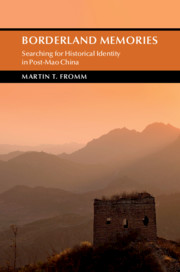Book contents
- Borderland Memories
- Cambridge Studies in the History of the People’s Republic of China
- Studies of the Weatherhead East Asian Institute, Columbia University
- Borderland Memories
- Copyright page
- Dedication
- Contents
- Acknowledgments
- Introduction
- 1 Reconfiguring Cultural Production in the Post-Mao Transition
- 2 Borderland Ambiguities in Narratives of Modernization and Liberation
- 3 Relocating the Nation outside the Nation
- 4 The “Historical Science” of Wenshi Ziliao
- 5 Affective Community and Historical Rehabilitation
- 6 Mobilizing a “Patriotic United Front”
- 7 Local, Regional, and National Dynamics of Wenshi Ziliao Production
- Conclusion
- References
- Index
- Studies of the Weatherhead East Asian Institute, Columbia University
6 - Mobilizing a “Patriotic United Front”
Published online by Cambridge University Press: 18 February 2019
- Borderland Memories
- Cambridge Studies in the History of the People’s Republic of China
- Studies of the Weatherhead East Asian Institute, Columbia University
- Borderland Memories
- Copyright page
- Dedication
- Contents
- Acknowledgments
- Introduction
- 1 Reconfiguring Cultural Production in the Post-Mao Transition
- 2 Borderland Ambiguities in Narratives of Modernization and Liberation
- 3 Relocating the Nation outside the Nation
- 4 The “Historical Science” of Wenshi Ziliao
- 5 Affective Community and Historical Rehabilitation
- 6 Mobilizing a “Patriotic United Front”
- 7 Local, Regional, and National Dynamics of Wenshi Ziliao Production
- Conclusion
- References
- Index
- Studies of the Weatherhead East Asian Institute, Columbia University
Summary
Differentiating wenshi ziliao from other kinds of history production such as gazetteers and Party histories, organizers emphasized the integration of oral history with political mobilization. Internal circulation embodied the diversity/unity strategy of the Party by creating a “safe zone” for celebrating inclusivity and plurality of expression in which Party officials, informants, writers, and editors could experiment locally with different variations of reform discourse in the realm of history. It contained heterogeneity within a framework of controlled distribution to a select group of government, Party, and academic institutions along with work units in targeted industries. Yet they remained ambivalent. The inclusiveness and diversity of the wenshi ziliao, while essential to the tasks of building a united front and bringing about political healing and reconciliation, made it difficult for the Party to control the political message that they conveyed. Unlike the previous Maoist campaigns of mass mobilization, the wenshi ziliao were a restricted approach to mobilization that involved a selective network of local elites and a semi-internal framework for publication and dissemination. They integrated the Maoist methods of mass line and investigative research with a more controlled, selective mobilization process.
Keywords
- Type
- Chapter
- Information
- Borderland MemoriesSearching for Historical Identity in Post-Mao China, pp. 200 - 222Publisher: Cambridge University PressPrint publication year: 2019

